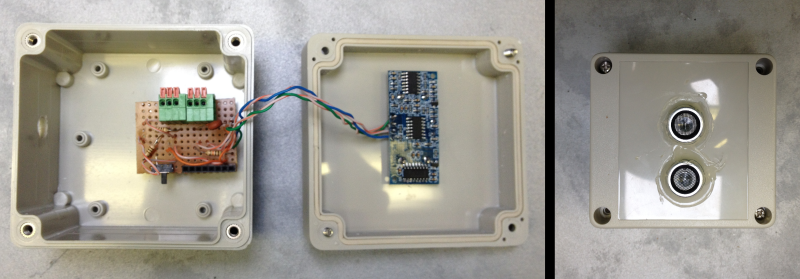[Peter] is doing his part toward protecting the environment and conserving water. He’s built a rainwater collection system complete with an underground storage tank. Since he wanted to monitor the water level in the tank, he made a level indicating system. Everything was going well until one day out of nowhere it stopped working, only returning 0’s as the level. [Peter] took a look and found that I slug had made its way into the electronics enclosure and slimed up the traces on the PCB, causing short circuits.To fix the problem [Peter] decided to redesigned the system. This time it would be built into an all-weather electrical box. The system uses a standard hobby ultrasonic range finder to measure the distance from the top of the tank to the level of the water. Two holes cut into the electrical box allow the sender/receiver components to peek outside of the enclosure. Any gaps were then filled with sealant. [Peter] also added a thermistor to measure the temperature inside the tank.The sensor values are read by an Arduino and sent wirelessly to [Peter]’s computer via a pair of XBee’s and a second Arduino with an ethernet shield. The data are sent in 3 minute intervals and automatically stored in a MySQL database for quick reference of level and temperature trends. Now [Peter] can monitor his rain water remotely and adjust his usage habits accordingly. Want to read more about water tanks? Check out this overflow monitor system.
Water Tank Monitoring System Is Now Slug-Proof
















Fascinating. I had no idea that slug slime was conductive. Nicely done solution to the problem.
slug slime as pcb traces?
Someone should put some slugs on a piece of paper and let them slime around for a bit. Then throw some LEDs and a 9 volt at the thing and see the beauty. It would be an organic random circuit generator
I slug? Like I-Robot, but with a bit more gastropod? Perhaps it’s roman numerals? Sorry, I’m being pedantic, but reading over errors like that breaks my immersion in the discussion of the hack
They should be giving out store credit for finding errors…
Considering every article has glaring errors like this, they’d go bust in a few weeks.
the one that caught me was “the data are sent…”
It’s the comment chains like this that just make me sit back, smile, and say, “yes. this is exactly what I wanted.”
That’s arguably correct, as datum is the singular and data the plural, though common usage is gradually phasing out the use of datum, and is using data instead.
Ah yes, Brian, we’ve progressed past “rolling with the punches” to the next stage, “the puppet-master defense”.
Data is actually plural for Datum, a Latin word. So “data are sent” is correct.
@Yarr – Or maybe “trolling with the punches”? x-)
Wouldn’t slime trails across the transducers also cause issues?
To fix the problem [Peter] decided to redesigned the system.
You know the editors get a FAIL, even for an engineer the grammar / spelling sucks here for what, 4 years ?
When Fritzling pictures are used without accomplying schematic diagrams, it makes my brain hurt.
While we are on the subject of rainwater. My biggest system EVER:
http://Www.rainharvester.blogspot.com
I really love that 3D picture in the site. I wish more people would use that. Cross eyed 3d is amazing once you get the hang of it. It really gives your brain good info too. I take 2 pictures many times so (one for each eye) I can view them in 3d later.
I check my water level in my aquaponics by a simple probe made of cat 5 wires.
In two years, they haven’t corroded because I only sample once a second.
If slugs don’t do it spiders their poop and their webs will, combined with moisture and condensation.
Salt or ammonia spray kills slugs but, circuits too.
I have worked a lot with these sensors during my phD in hydraulics and im abit scared that in time the system will fail again, since the sensor will be hanging above the water surface all the time, and thus corrosion will get a hold of them.
Furthermore i wonder whether he uses the thermistor to calculate the sound velocity, since it is (highly) temperature dependent.
I also found out that the accuracy of the device shows some strange behaviour, which can be backtracked to the applied measurement frequency, resulting in the fact that the device cant measure more precise than 4/5mm resolution.
http://forums.parallax.com/showthread.php/155758-USing-Ping)))-sensor-for-academic-purposes
In my setup I also have the sensors in a electrical enclosure, coupled with a custom made pcb (by hand) with an underclocked chip at 8Mhz in order to save battery, and a nrf24l01 for the communication.
It measures every 5 seconds, and goes to sleep in between .
The sensor goes into deep sleep itsself when the base station is not up, and pings for a connection every minute.
If I remember correctly the system uses about 40µA of my 2 1,5V batteries while up, and about 6µA when in deep sleep.
This gives me incredible flexibility and long battery life.
The option that the deep sleep sets in if the base station is turned off is very handy, since we dont need a 24/7 monitoring, and this way no-one can forget to put the devices off.
You can get waterproof transducers that are ping compatible for $10, they’re what I use.
Example link please?
“Back in my day we had bugs, not slugs. What is this world coming too?!” – Some old guy
spraying some clear coat on the board would probably help.
People who are complaining about the grammar, are paying how much to have the right to complain about the editors ?